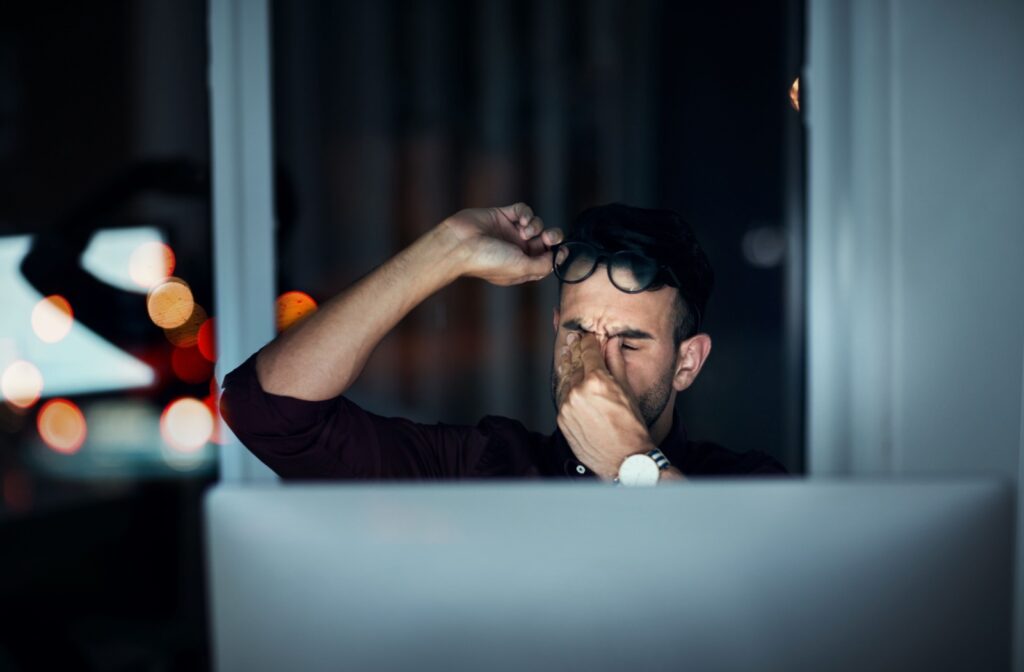After spending hours glued to a computer screen working or studying, you may be blinking furiously, trying to feel comfortable again. If this sounds all too familiar, you’re not alone. In today’s digital age, eye strain is a common complaint among everyone, from students to professionals.
Eye strain can last as long as you engage in tasks that require your eyes, like reading or using a computer. It typically fades within an hour after a break, but its duration can vary based on your eye health and how long you’ve been visually active. If you struggle to get through a workday, your optometrist can help you find relief!
What Is Eye Strain?
Eye strain is the discomfort experienced after prolonged visual stress. When it’s caused by too much screen time, it’s often called digital eye strain or computer vision syndrome. While many assume that only those with existing vision problems suffer from eye strain, the truth is that even those with seemingly perfect vision can experience it.
Digital eye strain can manifest in various ways. Common symptoms can include:
- Eye fatigue
- Dry eye
- Blurriness
- Double vision
- Headaches
- Redness and irritation
- Neck and shoulder pain
Eye strain isn’t typically dangerous in the long term, but it can affect your productivity and simply make your day more frustrating.
Factors Affecting Recovery Time
Most people report their eye strain fades about an hour after stepping away from the task that caused it. However, the duration of eye strain can vary widely depending on several factors.
Unsurprisingly, the longer you spend in front of a screen, the more likely you are to experience eye strain and the longer it may last. Using digital screens at a relatively close distance can cause our eyes to focus continuously for extended periods. Imagine you’re constantly holding a weight out in front of you. Your arms would get tired, right? Same for your eyes.
When focused on a screen, we blink less often, averaging 5–7 times per minute instead of the normal 15 times per minute. Blinking is essential for tear production, and a decrease can lead to dry eye, a common symptom of digital eye strain.
Poor lighting can also exacerbate eye strain. Whether it’s a dimly lit room or harsh fluorescent lights, improper lighting can make it harder for your eyes to focus.
Not all eyes are the same. Factors like age, existing vision problems, and even the quality of your glasses or contact lenses can influence how long eye strain lasts. It is up to you and your optometrist to work together to determine what is causing your eyestrain.
Tips for Preventing Eye Strain
There is good news. You have the power to alleviate digital eye strain through some simple yet effective strategies. Here are some of our practical tips:
- Take regular screen breaks: Follow the 20-20-20 rule. Every 20 minutes, look at something 20 feet away for at least 20 seconds. Additionally, give your eyes a rest for 5 minutes every hour. Close them, look out the window, or take a short walk.
- Remember to blink: Blinking is an easy yet often overlooked way to keep your eyes moist. When we’re focused on screens, our blink rate decreases significantly. Make a conscious effort to blink more frequently.
- Make your workspace work for you: Adjust your screen’s brightness and contrast to comfortable levels. Ensure your workspace is well-lit but not too bright, as glare can increase the risk of eye strain.
- Maintain proper posture: Sit straight with your feet flat on the floor. Position your screen about an arm’s length away and slightly below eye level. This can help avoid neck and shoulder pain as well.
- Check your vision regularly: Routine eye exams are crucial. They’re not just about updating your prescription; they also serve as a checkup on the health and well-being of your eyes.
If your eye strain is persistent or severe, it’s essential to consult an optometrist or ophthalmologist. Professional advice can help identify underlying issues and provide tailored solutions. For example, you may have a vision problem that doesn’t affect most of your day, but extended screen time is just the catalyst it needs to present itself. Your optometrist could recommend glasses to help you see comfortably.
In some cases, discomfort from eye strain can be the first sign of an eye disease. Don’t ignore the signs; early intervention can prevent more serious problems.
Your Eyes Deserve Better
Eye strain is a common issue, but it doesn’t have to be a constant companion. By understanding its causes and implementing practical solutions, you can enjoy a more comfortable and productive screen time. Remember, your eyes are worth taking care of!
If you’re struggling with eye strain and need personalized advice, don’t hesitate to book an appointment with us at Eyes on Plainville. Our team is here to help you find solutions tailored to your needs so you can reduce eye strain and discomfort and enjoy a clearer, more comfortable view.
Take the first step towards healthier eyes today—schedule your eye exam.





